Fish Swimming Behavior and Strategies Under Different Hydrodynamic Conditions in Fishways with Various Vertical Slot Configurations
Abstract
1. Introduction
2. Materials and Methods
2.1. Experimental Fish
2.2. Experimental Design
2.3. Indicators of Fish Behaviors
2.4. Computational Fluid Dynamics Model
2.4.1. Model Setup
2.4.2. Model Validation
3. Results
3.1. Hydrodynamic Characteristics
3.2. Passage Efficiency and Swimming Preference
3.3. Behavioral Tactics Under Near-Field Hydrodynamics
3.4. Fish Tail-Beat Kinematics Characteristics
3.5. Drivers of Swimming Behaviors and Strategies
4. Discussion
4.1. Hydrodynamic Efficiency of Vertical Slot Designs
4.2. Passage Efficiency of Vertical Slots
4.3. Behavioral Mechanisms and Energy Optimization
4.4. Limitations and Future Directions
5. Conclusions
Author Contributions
Funding
Institutional Review Board Statement
Informed Consent Statement
Data Availability Statement
Acknowledgments
Conflicts of Interest
Abbreviations
| CFD | Computational Fluid Dynamics |
| COVS | Central Orifice Vertical Slot |
| SVS | Standard Vertical Slot |
| LVS | L-shaped Vertical Slot |
| DO | Dissolved Oxygen |
| VOF | Volume of Fluid |
| ADV | Acoustic Doppler Velocimeter |
| PCA | Principal Component Analysis |
References
- Shi, X.; Kynard, B.; Liu, D.; Qiao, Y.; Chen, Q. Development of fish passage in China. Fisheries 2015, 40, 161–169. [Google Scholar] [CrossRef]
- Duponchelle, F.; Isaac, V.J.; Rodrigues Da Costa Doria, C.; Van Damme, P.A.; Herrera-R, G.A.; Anderson, E.P.; Castello, L. Conservation of migratory fishes in the Amazon basin. Aquat. Conserv. Mar. Freshw. Ecosyst. 2021, 31, 1087–1105. [Google Scholar] [CrossRef]
- Latrubesse, E.; Arima, E.; Dunne, T.; Park, E.; Baker, V.R.; D’Horta, F.M.; Wight, C.; Wittmann, F.; Zuanon, J.; Baker, P.A.; et al. Damming the rivers of the Amazon basin. Nature 2017, 546, 363–369. [Google Scholar] [CrossRef]
- Romão, F.; Quaresma, A.L.; Santos, J.M.; Branco, P.; Pinheiro, A.N. Cyprinid passage performance in an experimental multislot fishway across distinct seasons. Mar. Freshw. Res. 2019, 70, 881–890. [Google Scholar] [CrossRef]
- Tan, J.J.; Gao, Z.; Dai, H.C.; Shi, X. The correlation analysis between hydraulic characteristics of vertical slot fishway and fish movement characteristics. J. Hydraul. Eng. 2017, 48, 924–932. [Google Scholar] [CrossRef]
- Shi, X.; Deng, X.; Chen, X.; Wang, Y.; Hu, X.; Tan, J. Simulation of the upstream behavior of Schizothorax wangchiachii in vertical slot fishway. Trans. Chin. Soc. Agric. Eng. 2025, 41, 175–184. [Google Scholar] [CrossRef]
- Mao, X. Review of fishway research in China. Ecol. Eng. 2018, 115, 91–95. [Google Scholar] [CrossRef]
- Xi, Y.; Cao, C.; Liu, S.; Li, P.; Xiao, L.; Yao, W. Swimming behaviour of downstream migrating carp in accelerating flows. J. Hydraul. Res. 2024, 62, 253–266. [Google Scholar] [CrossRef]
- Keefer, M.L.; Jepson, M.A.; Clabough, T.S.; Caudill, C.C. Technical fishway passage structures provide high passage efficiency and effective passage for adult Pacific salmonids at eight large dams. PLoS ONE 2021, 16, e0256805. [Google Scholar] [CrossRef] [PubMed]
- Bunt, C.M. Fishway entrance modifications enhance fish attraction. Fish. Manag. Ecol. 2001, 8, 95–105. [Google Scholar] [CrossRef]
- Song, C.; Omalley, A.; Roy, S.G.; Barber, B.L.; Zydlewski, J.; Mo, W. Managing dams for energy and fish tradeoffs: What does a win-win solution take? Sci. Total Environ. 2019, 669, 833–843. [Google Scholar] [CrossRef]
- Li, G.; Sun, S.; Liu, H.; Zheng, T. Schizothorax prenanti swimming behavior in response to different flow patterns in vertical slot fishways with different slot positions. Sci. Total Environ. 2021, 754, 142142. [Google Scholar] [CrossRef]
- Marriner, B.A.; Baki, A.B.; Zhu, D.Z.; Cooke, S.J.; Katopodis, C. The hydraulics of a vertical slot fishway: A case study on the multi-species Vianney-Legendre fishway in Quebec, Canada. Ecol. Eng. 2016, 90, 190–202. [Google Scholar] [CrossRef]
- Puertas, J.; Cea, L.; Bermúdez, M.; Pena, L.; Rodríguez, Á.; Rabuñal, J.R.; Aramburu, E. Computer application for the analysis and design of vertical slot fishways in accordance with the requirements of the target species. Ecol. Eng. 2021, 48, 51–60. [Google Scholar] [CrossRef]
- Rajaratnam, N.; Katopodis, C.; Solanki, S. New designs for vertical slot fishways. Can. J. Civ. Eng. 1992, 19, 402–414. [Google Scholar] [CrossRef]
- Li, Y.; Wang, X.; Xuan, G.; Liang, D. Effect of parameters of pool geometry on flow characteristics in low slope vertical slot fishways. J. Hydraul. Res. 2020, 58, 395–407. [Google Scholar] [CrossRef]
- Katopodis, C.; Cai, L.; Johnson, D. Sturgeon survival: The role of swimming performance and fish passage research. Fish. Res. 2019, 212, 162–171. [Google Scholar] [CrossRef]
- Ballu, A.; Calluaud, D.; Pineau, G.; David, L. Experimental study of the influence of macro-roughnesses on vertical slot fishway flows. La Houille Blanche 2017, 103, 9–14. [Google Scholar] [CrossRef]
- Ballu, A.; Pineau, G.; Calluaud, D.; David, L. Influence of macro-roughnesses on vertical slot fishways. In Proceedings of the 7th International Symposium on Hydraulic Structures, Aachen, Germany, 14–18 May 2018. [Google Scholar] [CrossRef]
- Li, G.; Sun, S.; Liu, H.; Zheng, T.; Zhang, C. Water profiles in vertical slot fishways without central baffle. Int. J. Heat Technol. 2017, 35, 191–195. [Google Scholar] [CrossRef]
- Noonan, M.J.; Grant, J.W.; Jackson, C.D. A quantitative assessment of fish passage efficiency. Fish Fish. 2012, 13, 450–464. [Google Scholar] [CrossRef]
- Bao, J.; Li, W.; Zhang, C.; Mi, X.; Li, H.; Zhao, X.; Duan, M. Quantitative assessment of fish passage efficiency at a vertical-slot fishway on the Daduhe River in Southwest China. Ecol. Eng. 2019, 141, 105597. [Google Scholar] [CrossRef]
- Shi, K.; Li, G.; Liu, S.; Sun, S.; Zheng, T.; Liu, H. An improved method of local coloring in vertical-slot fishways to enhance the fish migration effect of grass carp. J. Environ. Manag. 2024, 363, 121390. [Google Scholar] [CrossRef] [PubMed]
- Shi, K.; Li, G.; Liu, S.; Sun, S. Experimental study on the passage behavior of juvenile Schizothorax prenanti by configuring local colors in the vertical slot fishways. Sci. Total Environ. 2022, 843, 156989. [Google Scholar] [CrossRef] [PubMed]
- Silva, A.T.; Bærum, K.M.; Hedger, R.D.; Baktoft, H.; Fjeldstad, H.P.; Gjelland, K.Ø.; Forseth, T. The effects of hydrodynamics on the three-dimensional downstream migratory movement of Atlantic salmon. Sci. Total Environ. 2020, 705, 135773. [Google Scholar] [CrossRef]
- Zheng, T.; Niu, Z.; Sun, S.; Huang, W.; Tu, C.; Liu, H.; Wang, H. Optimizing fish-friendly flow pattern in vertical slot fishway based on fish swimming capability validation. Ecol. Eng. 2022, 185, 106796. [Google Scholar] [CrossRef]
- Tan, J.; Gao, Z.; Dai, H.; Yang, Z.; Shi, X. Effects of turbulence and velocity on the movement behaviour of bighead carp (Hypophthalmichthys nobilis) in an experimental vertical slot fishway. Ecol. Eng. 2019, 127, 363–374. [Google Scholar] [CrossRef]
- Shirinzad, A.; Kumahor, S.; Tachie, M.F.; Ghamry, H.; Katopodis, C. Investigation of turbulent flows using spillway models aiming to aid downstream migration of fish. River Res. Appl. 2023, 39, 1110–1121. [Google Scholar] [CrossRef]
- Li, J.; Li, J.; Gong, P.; Guan, C. Effects of the artificial reef and flow field environment on the habitat selection behavior of Sebastes schlegelii juveniles. Appl. Anim. Behav. Sci. 2021, 245, 105492. [Google Scholar] [CrossRef]
- Gualtieri, C.; Abdi, R.; Ianniruberto, M.; Filizola, N.; Endreny, T. A 3D analysis of spatial habitat metrics about the confluence of Negro and Solimões Rivers Brazil. Ecohydrology 2020, 13, e2166. [Google Scholar] [CrossRef]
- Yuan, S.; Qiu, J.; Tang, H.; Xu, L.; Xiao, Y.; Liu, M.; Rennie, C.; Gualtieri, C. Fish community traits near a large confluence: Implications for its nodal effects in the river ecosystem. J. Hydrol. 2023, 626, 130335. [Google Scholar] [CrossRef]
- Enders, E.C.; Boisclair, D.; Roy, A.G. The effect of turbulence on the cost of swimming for juvenile Atlantic salmon (Salmo salar). Can. J. Fish. Aquat. Sci. 2003, 60, 1149–1160. [Google Scholar] [CrossRef]
- Piper, A.T.; Manes, C.; Siniscalchi, F.; Marion, A.; Wright, R.M.; Kemp, P.S. Response of seaward-migrating European eel (Anguilla anguilla) to manipulated flow fields. Proc. R. Soc. B Biol. Sci. 2015, 282, 20151098. [Google Scholar] [CrossRef]
- Johansen, J.L.; Akanyeti, O.; Liao, J.C. Oxygen consumption of drift-feeding rainbow trout: The energetic tradeoff between locomotion and feeding in flow. J. Exp. Biol. 2020, 223, jeb220962. [Google Scholar] [CrossRef]
- Lacey, R.W.J.; Neary, V.S.; Liao, J.C.; Enders, E.C.; Tritico, H.M. The IPOS framework: Linking fish swimming performance in altered flows from laboratory experiments to rivers. River Res. Appl. 2012, 28, 429–443. [Google Scholar] [CrossRef]
- Roth, M.S.; Jähnel, C.; Stamm, J.; Schneider, L.K. Turbulent eddy identification of a meander and vertical-slot fishways in numerical models applying the IPOS-framework. J. Ecohydraulics 2022, 7, 124–143. [Google Scholar] [CrossRef]
- Tang, H.; Wang, H.; Yuan, S.; Qiu, J.; Li, Z.; Shi, X.; Gualtieri, C. Inhibited swimming capacity of fish entrained in wake vortices behind a semi-cylinder. Ocean Eng. 2024, 293, 116617. [Google Scholar] [CrossRef]
- Smith, D.L.; Goodwin, R.A.; Nestler, J.M. Relating turbulence and fish habitat: A new approach for management and research. Rev. Fish. Sci. Aquac. 2014, 22, 123–130. [Google Scholar] [CrossRef]
- Shahabi, M.; Ghomeshi, M.; Ahadiyan, J.; Mohammadian, T.; Katopodis, C. Do fishways stress fish? Assessment of physiological and hydraulic parameters of rainbow trout navigating a novel W-weir fishway. Ecol. Eng. 2021, 169, 106330. [Google Scholar] [CrossRef]
- van der Hoop, J.M.; Byron, M.L.; Ozolina, K.; Miller, D.L.; Johansen, J.L.; Domenici, P.; Steffensen, J.F. Turbulent flow reduces oxygen consumption in the labriform swimming shiner perch, Cymatogaster aggregata. J. Exp. Biol. 2018, 221, jeb168773. [Google Scholar] [CrossRef] [PubMed]
- Liao, J.C.; Akanyeti, O. Fish swimming in a Kármán vortex street: Kinematics, sensory biology and energetics. Mar. Technol. Soc. J. 2017, 51, 48–55. [Google Scholar] [CrossRef]
- Liao, J.C.; Beal, D.N.; Lauder, G.V.; Triantafyllou, M.S. Fish exploiting vortices decrease muscle activity. Science 2003, 302, 1566–1569. [Google Scholar] [CrossRef]
- Xue, B.; Zhao, Y.; Bi, C.; Cheng, Y.; Ren, X.; Liu, Y. Investigation of flow field and pollutant particle distribution in the aquaculture tank for fish farming based on computational fluid dynamics. Comput. Electron. Agric. 2022, 200, 107243. [Google Scholar] [CrossRef]
- Mawer, R.; Pauwels, I.S.; Bruneel, S.P.; Goethals, P.L.; Kopecki, I.; Elings, J.; Schneider, M. Individual based models for the simulation of fish movement near barriers: Current work and future directions. J. Environ. Manag. 2023, 335, 117538. [Google Scholar] [CrossRef] [PubMed]
- Ouro, P.; Fraga, B.; Viti, N.; Angeloudis, A.; Stoesser, T.; Gualtieri, C. Instantaneous transport of a passive scalar in a turbulent separated flow. Environ. Fluid Mech. 2018, 18, 487–513. [Google Scholar] [CrossRef] [PubMed]
- Li, M.; An, R.; Chen, M.; Li, J. Evaluation of volitional swimming behavior of Schizothorax prenanti using an open-channel flume with spatially heterogeneous turbulent flow. Animals 2022, 12, 752. [Google Scholar] [CrossRef] [PubMed]
- Yuan, H.; Chen, B.; Sun, Q.; Xie, C.; He, X. Deciphering the effect of variation in slope on flow characteristics in a vertical slot fishway. J. Hydro-Environ. Res. 2024, 54, 1–12. [Google Scholar] [CrossRef]
- Wang, H.; Yuan, S.; Tang, H.; Gualtieri, C.; Ling, X. Hydrodynamic performance of swimming fish in the wake region of a semi-cylinder. Ocean Eng. 2025, 315, 119730. [Google Scholar] [CrossRef]
- Li, Z.; Guo, X.; Cui, M. Sensitive analyses of flow property to turbulence model in swirls simulation within aquaculture tanks. Ocean Eng. 2024, 291, 116425. [Google Scholar] [CrossRef]
- Lyubimova, T.P.; Lepikhin, A.P.; Parshakova, Y.N.; Kolchanov, V.Y.; Gualtieri, C.; Roux, B.; Lane, S.N. A numerical study of the influence of channel-scale secondary circulation on mixing processes downstream of river junctions. Water 2020, 12, 2969. [Google Scholar] [CrossRef]
- Zha, W.; Zeng, Y.; Katul, G.; Li, Q.; Liu, X.; Chen, X. Laboratory study on behavioral responses of hybrid sturgeon, Acipenseridae, to wake flows induced by cylindrical bluff bodies. Sci. Total Environ. 2021, 799, 149403. [Google Scholar] [CrossRef]
- Sparks, D.; Rajeev, E.; Koley, S.S.; Canestrelli, A.; Liao, J.C. Swimming kinematics of rainbow trout behind a 3×5 cylinder array: A computationally driven experimental approach to understanding fish locomotion. J. Exp. Biol. 2024, 227, jeb247873. [Google Scholar] [CrossRef]
- Link, O.; Sanhueza, C.; Arriagada, P.; Brevis, W.; Laborde, A.; González, A.; Habit, E. The fish Strouhal number as a criterion for hydraulic fishway design. Ecol. Eng. 2017, 103, 118–126. [Google Scholar] [CrossRef]
- Bao, J.; Wang, X.; Li, W.; Zhang, C.; Mi, X.; Zhang, D.; Duan, M. Passage efficiency and behavioral performance of Schizothorax davidi through different sections of a long vertical slot fishway. Water Biol. Secur. 2025, 4, 100330. [Google Scholar] [CrossRef]
- Zhang, D.; Xu, Y.; Deng, J.; Shi, X.; Liu, Y. Relationships among the fish passage efficiency, fish swimming behavior, and hydraulic properties in a vertical-slot fishway. Fish. Manag. Ecol. 2024, 31, e12681. [Google Scholar] [CrossRef]
- An, R.D.; Li, J.; Yi, W.M.; Mao, X. Hydraulics and swimming behavior of schizothorax prenanti in vertical slot fishways. J. Hydrodyn. 2019, 31, 169–176. [Google Scholar] [CrossRef]
- Liu, S.; Wang, N.; Gualtieri, C.; Zhang, C.; Cao, C.; Chen, J.; Bol Yaak, W.; Yao, W. Fish migration modeling and habitat assessment in a complex fluvial system. J. Environ. Manag. 2025, 374, 124146. [Google Scholar] [CrossRef]
- Cai, L.; Liu, G.; Taupier, R.; Fang, M.; Johnson, D.; Tu, Z.; Huang, Y. Effect of temperature on swimming performance of juvenile Schizothorax prenanti. Fish Physiol. Biochem. 2014, 40, 491–498. [Google Scholar] [CrossRef] [PubMed]
- Li, M.; Chen, M.; Wu, W.; Li, J.; An, R. Differences in the natural swimming behavior of Schizothorax prenanti individual and schooling in spatially heterogeneous turbulent flows. Animals 2023, 13, 1025. [Google Scholar] [CrossRef]
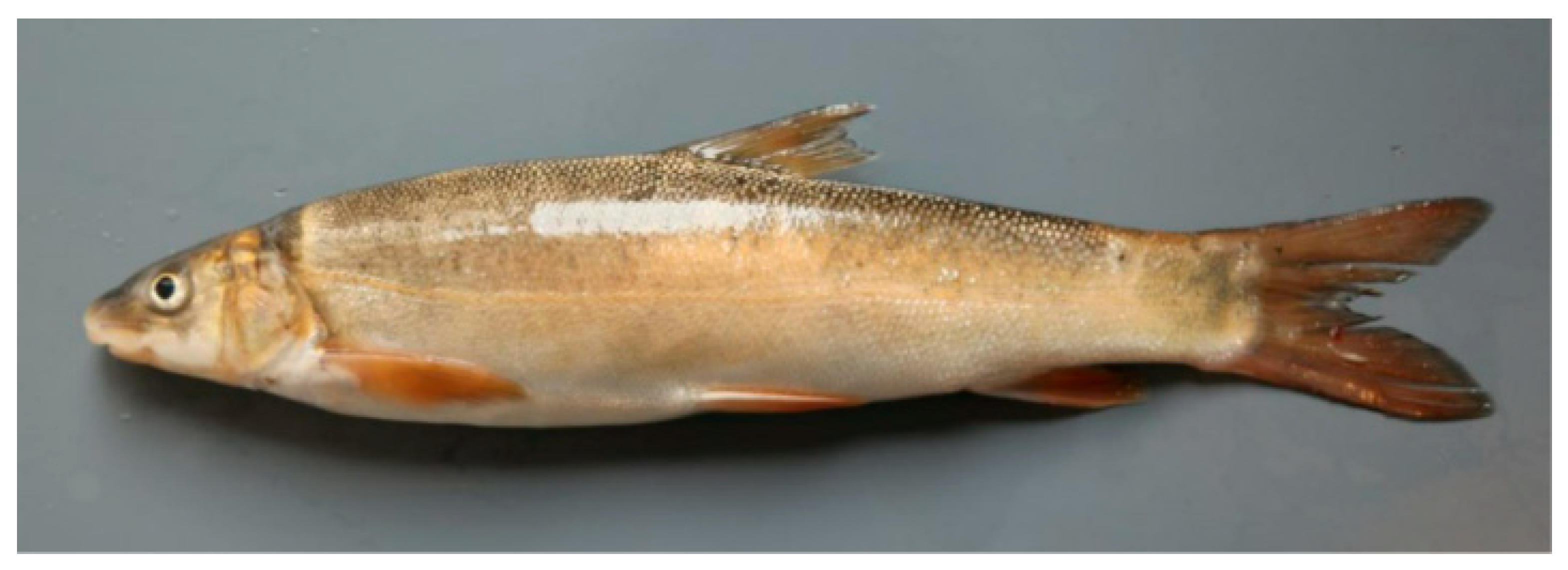
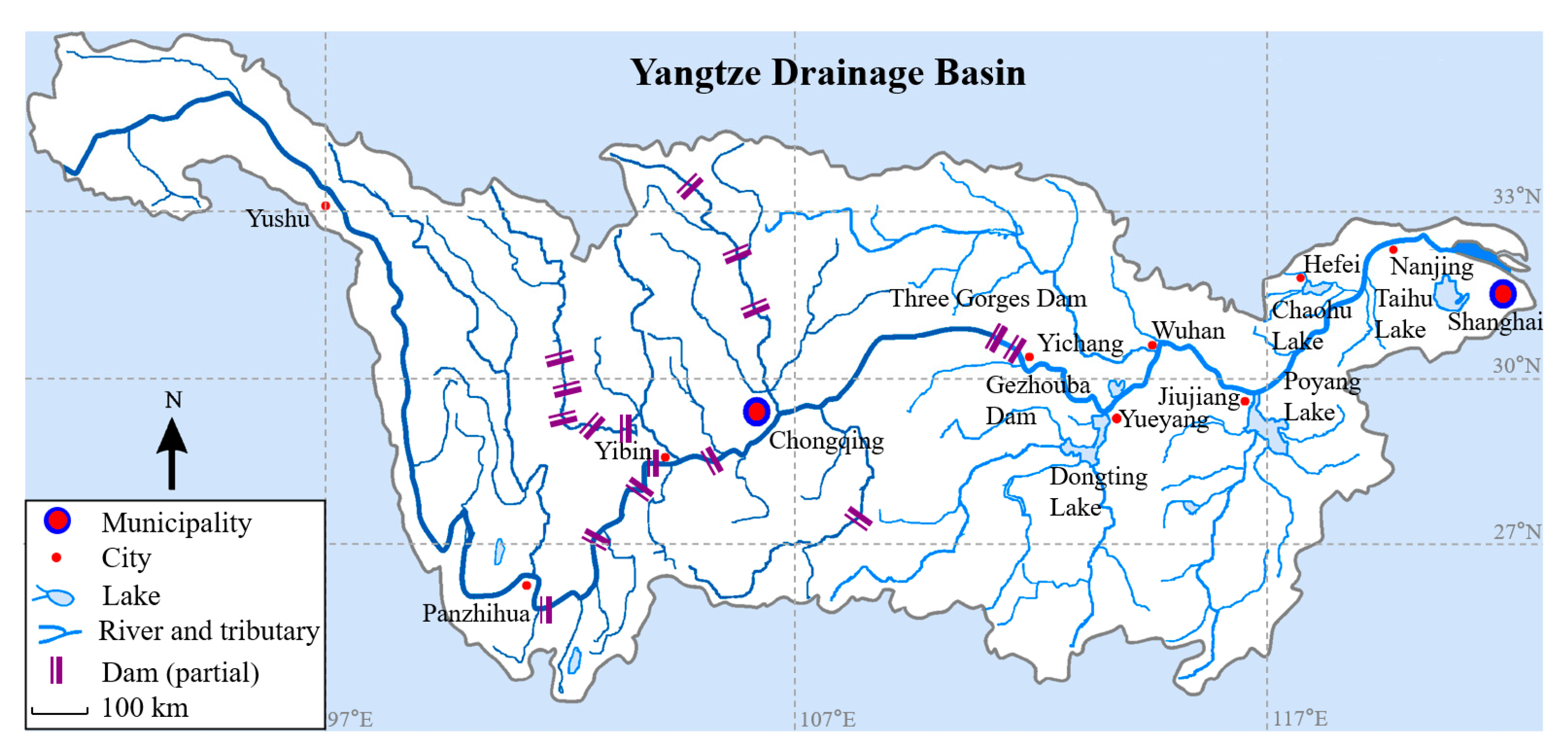
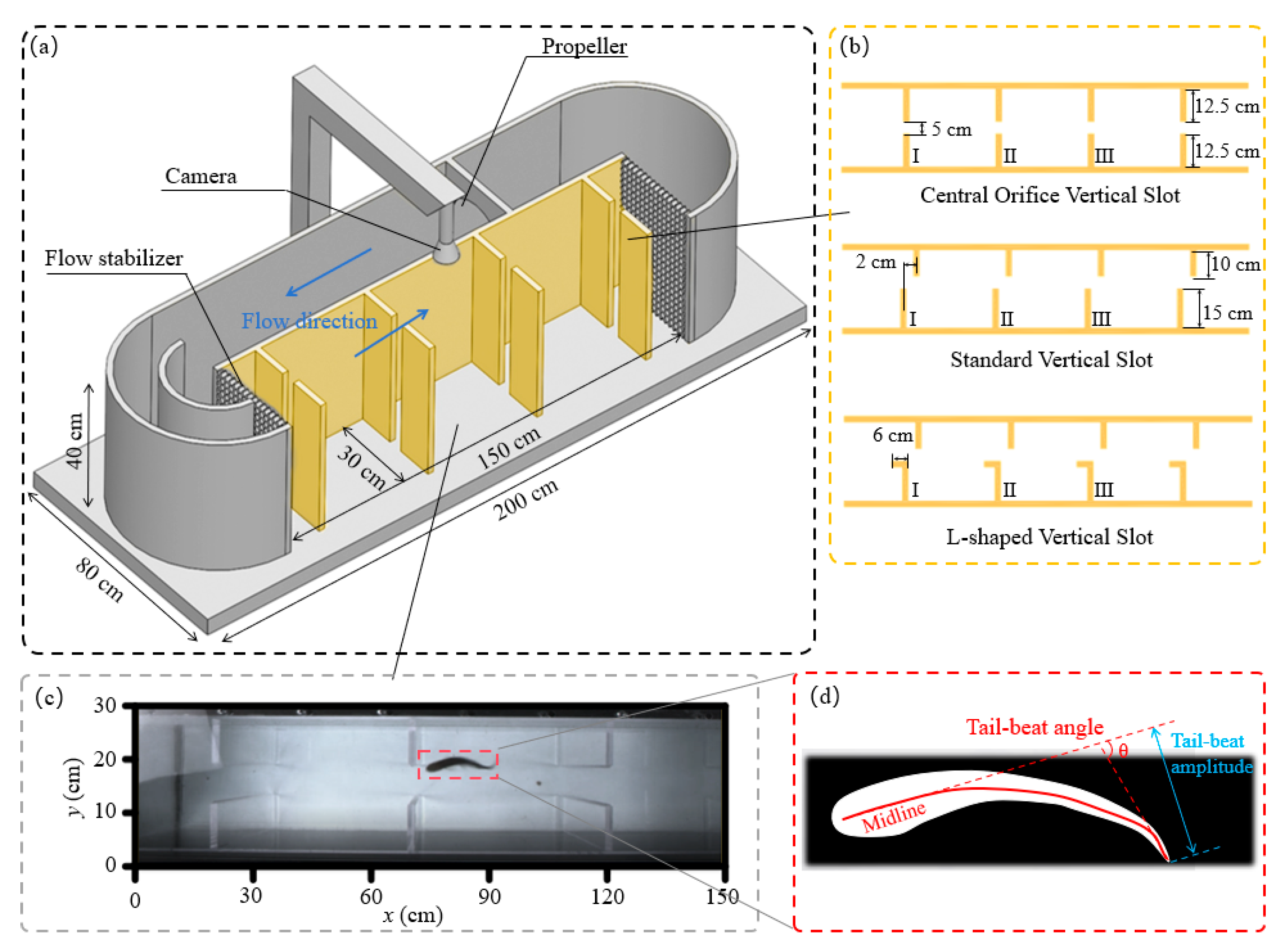

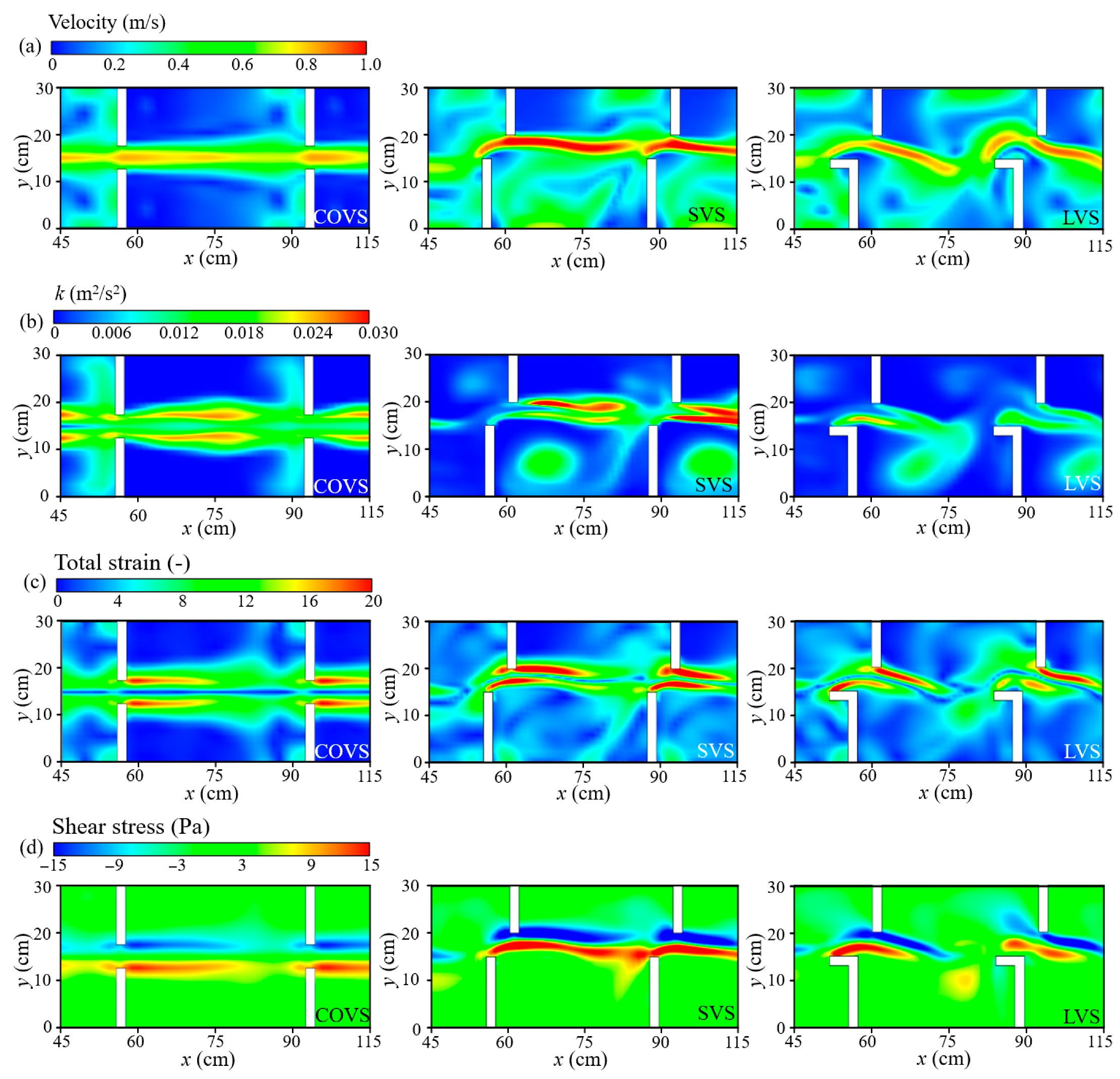
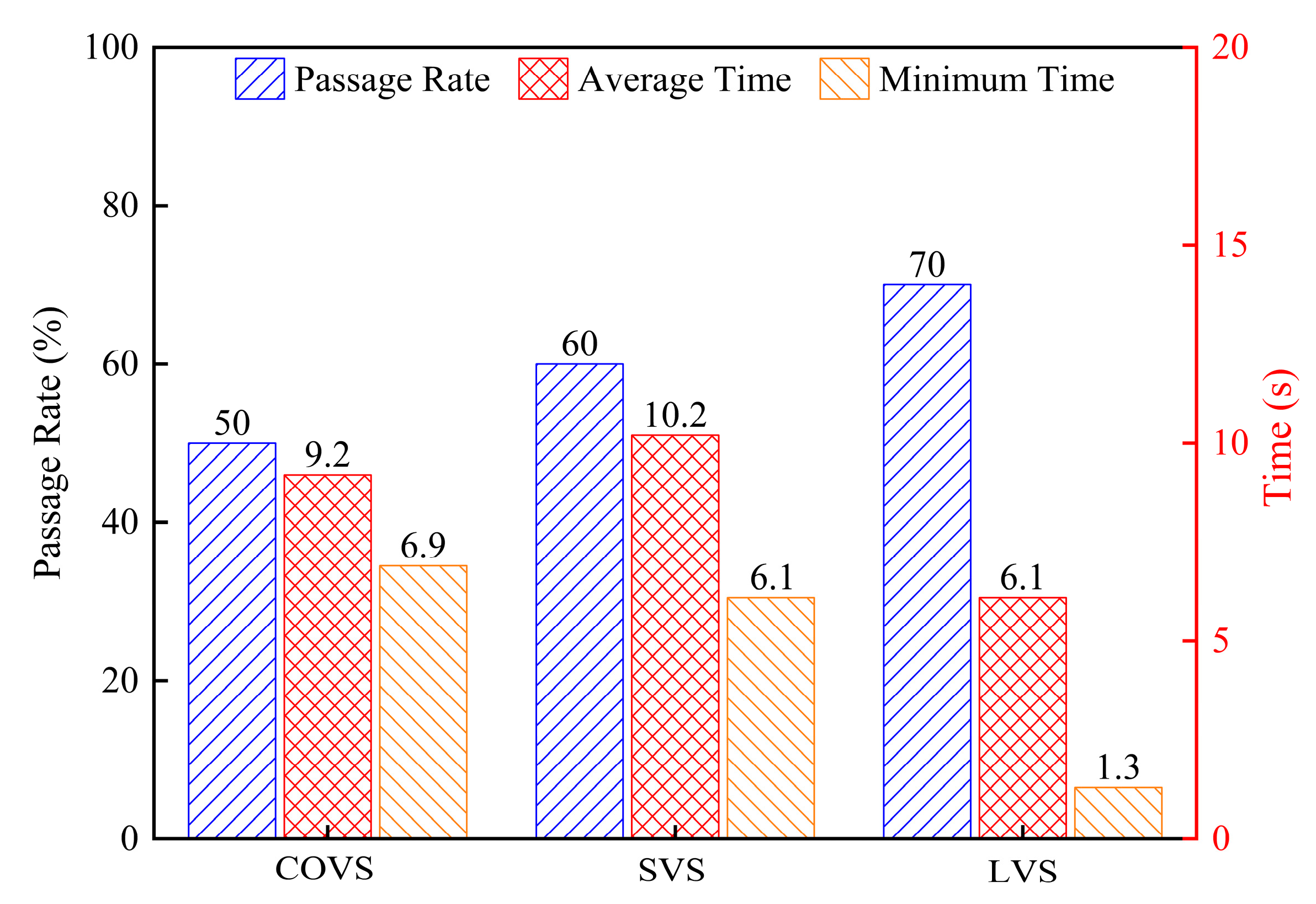

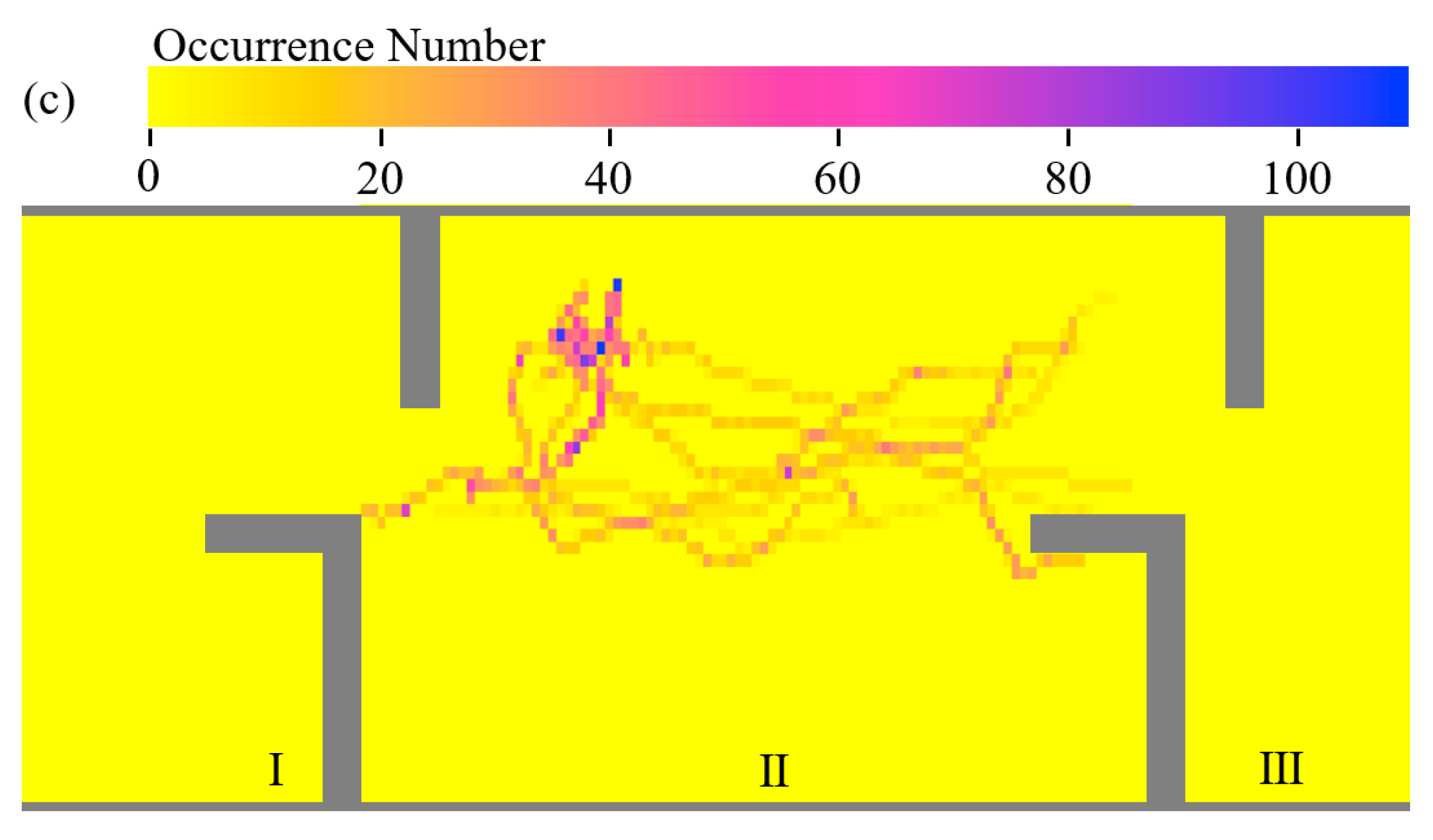

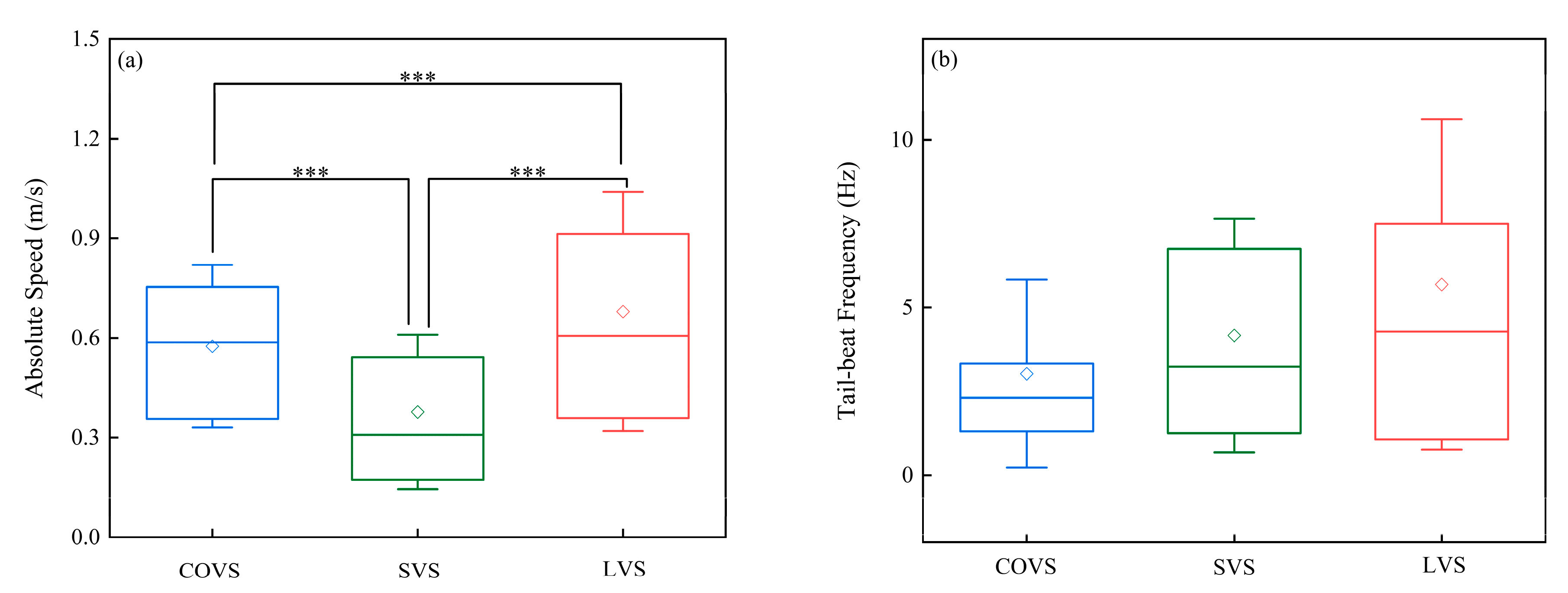
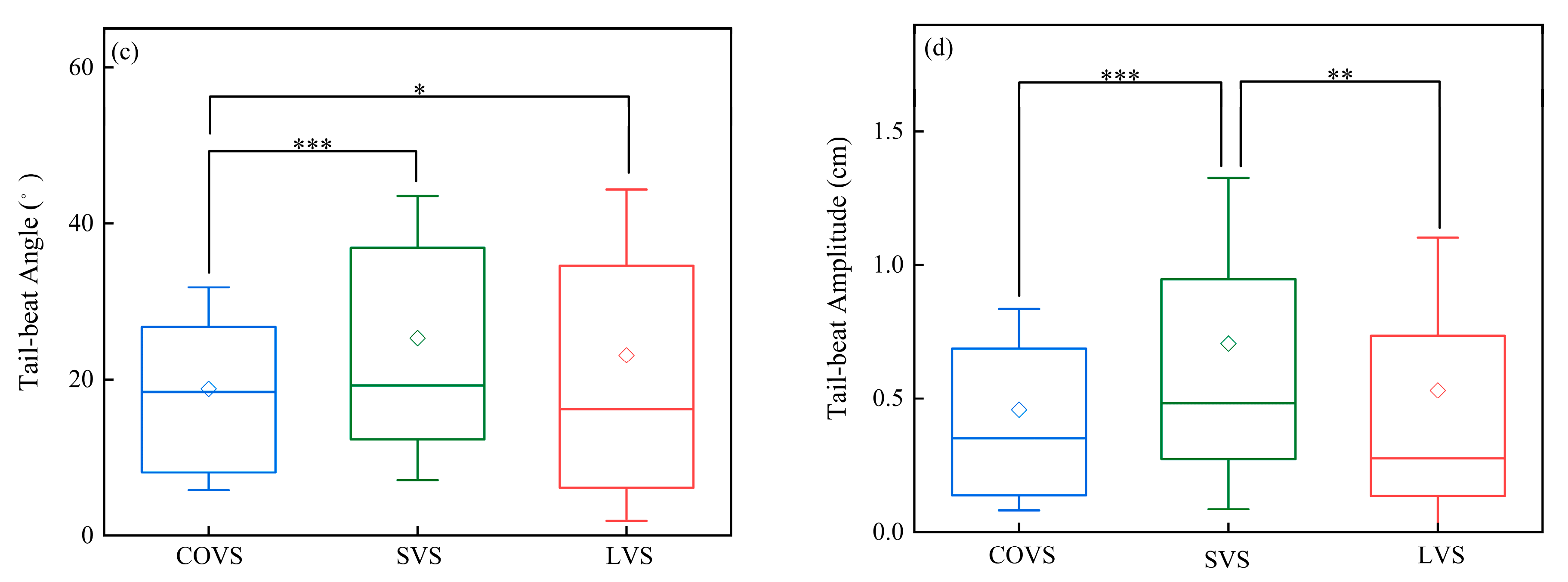
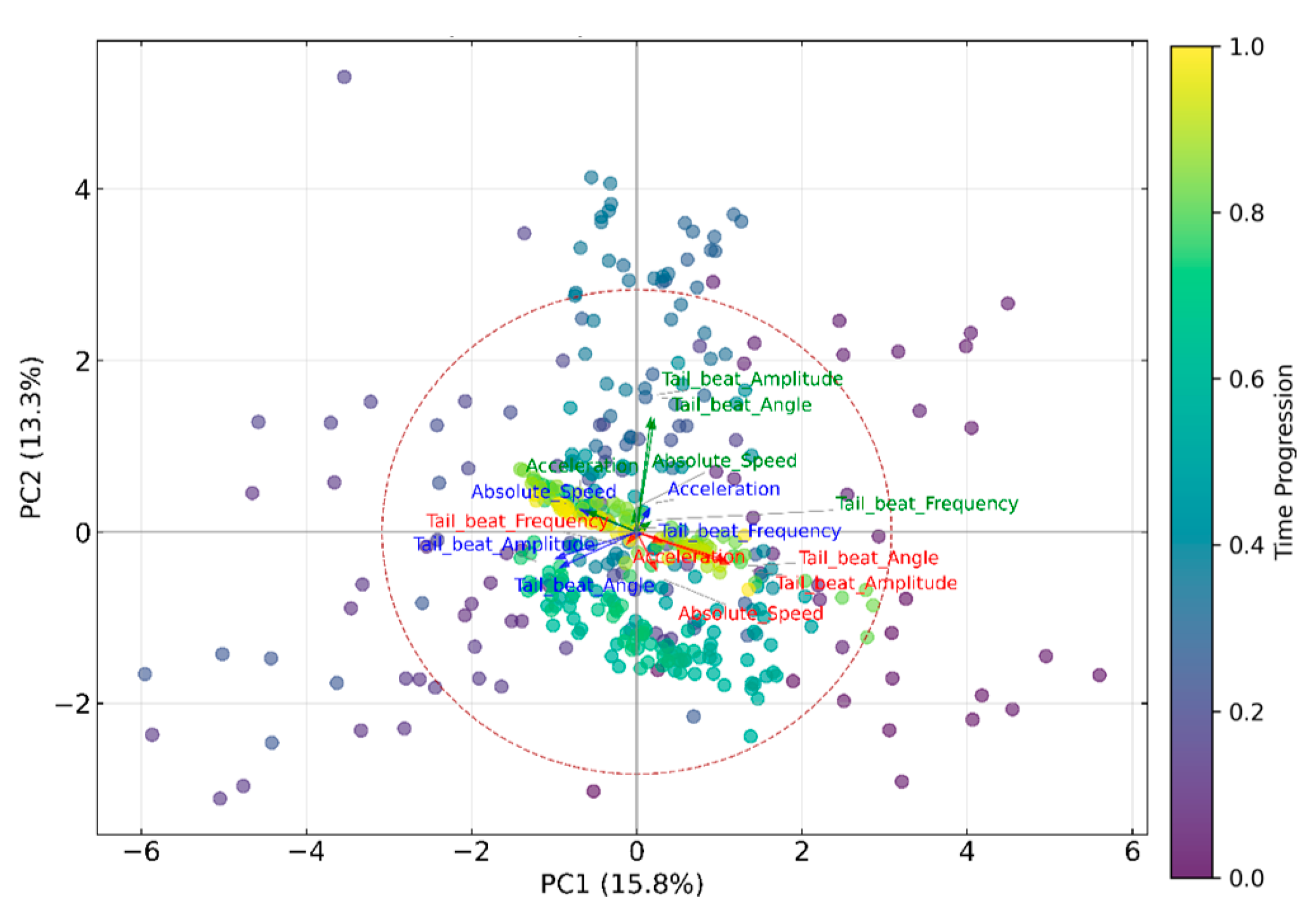
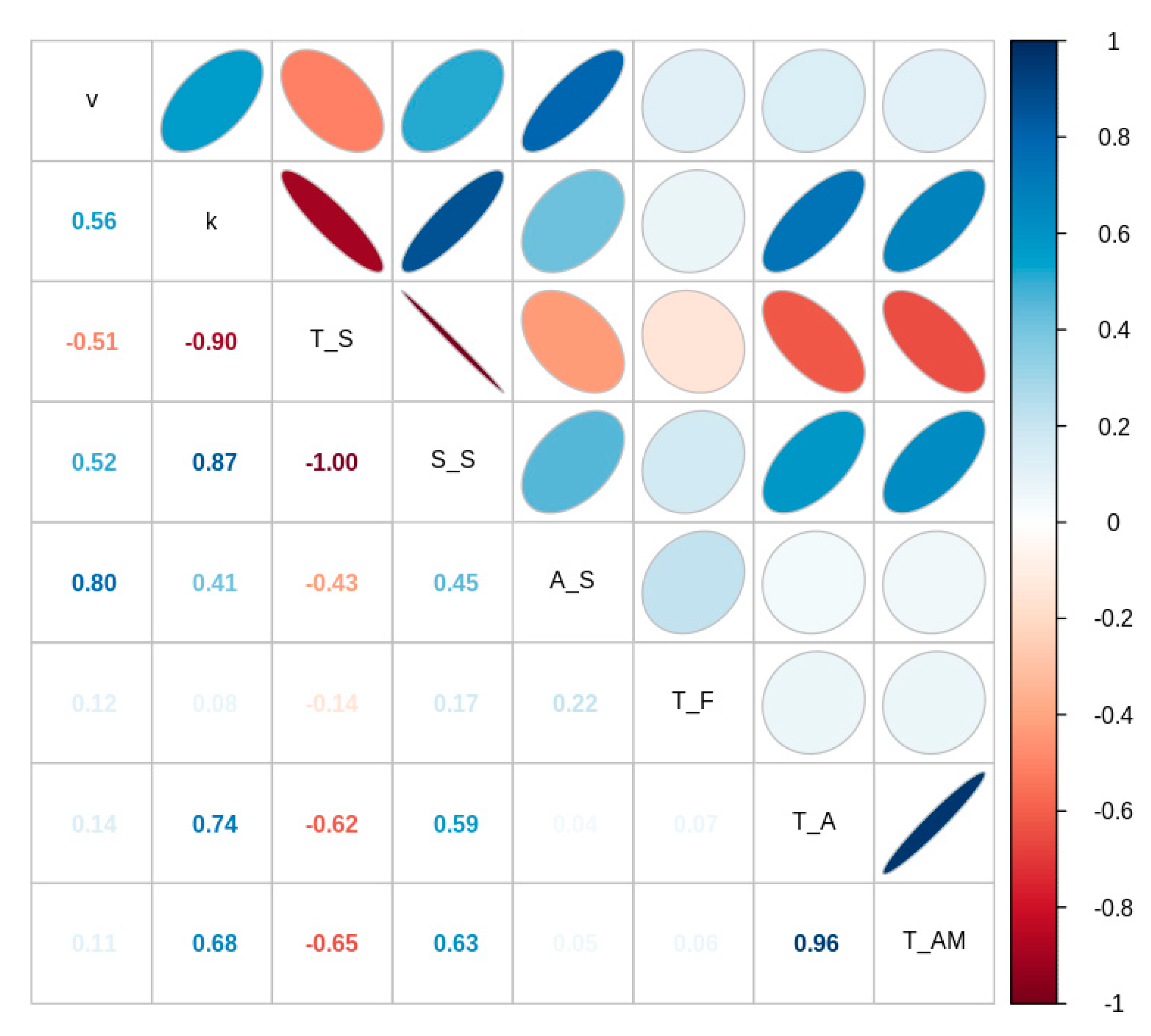
| Simulation Cases | Vertical Slot Type | Mesh Size (10−2 m) | Number of Grids | Calculation Time (s) |
|---|---|---|---|---|
| E1 | COVS | 1.4 × 0.5 × 0.725 1.4 × 0.72 × 0.725 | 105,096 | 2.22 |
| E2 | SVS | 1.04 × 0.36 × 0.725 1.04 × 1.1 × 0.725 | 182,152 | 2.03 |
| E3 | LVS | 1.04 × 0.36 × 0.725 1.04 × 1.1 × 0.725 | 182,152 | 2.03 |
Disclaimer/Publisher’s Note: The statements, opinions and data contained in all publications are solely those of the individual author(s) and contributor(s) and not of MDPI and/or the editor(s). MDPI and/or the editor(s) disclaim responsibility for any injury to people or property resulting from any ideas, methods, instructions or products referred to in the content. |
© 2025 by the authors. Licensee MDPI, Basel, Switzerland. This article is an open access article distributed under the terms and conditions of the Creative Commons Attribution (CC BY) license (https://creativecommons.org/licenses/by/4.0/).
Share and Cite
Ouyang, L.; Li, D.; Cui, S.; Wu, X.; Liu, Y.; Han, X.; Zhou, S.; Xu, G.; Tu, X.; Chen, K.; et al. Fish Swimming Behavior and Strategies Under Different Hydrodynamic Conditions in Fishways with Various Vertical Slot Configurations. Fishes 2025, 10, 415. https://doi.org/10.3390/fishes10080415
Ouyang L, Li D, Cui S, Wu X, Liu Y, Han X, Zhou S, Xu G, Tu X, Chen K, et al. Fish Swimming Behavior and Strategies Under Different Hydrodynamic Conditions in Fishways with Various Vertical Slot Configurations. Fishes. 2025; 10(8):415. https://doi.org/10.3390/fishes10080415
Chicago/Turabian StyleOuyang, Lijian, Dongqiu Li, Shihao Cui, Xinyang Wu, Yang Liu, Xiaowei Han, Shengzhi Zhou, Gang Xu, Xinggang Tu, Kang Chen, and et al. 2025. "Fish Swimming Behavior and Strategies Under Different Hydrodynamic Conditions in Fishways with Various Vertical Slot Configurations" Fishes 10, no. 8: 415. https://doi.org/10.3390/fishes10080415
APA StyleOuyang, L., Li, D., Cui, S., Wu, X., Liu, Y., Han, X., Zhou, S., Xu, G., Tu, X., Chen, K., Gualtieri, C., & Yao, W. (2025). Fish Swimming Behavior and Strategies Under Different Hydrodynamic Conditions in Fishways with Various Vertical Slot Configurations. Fishes, 10(8), 415. https://doi.org/10.3390/fishes10080415






